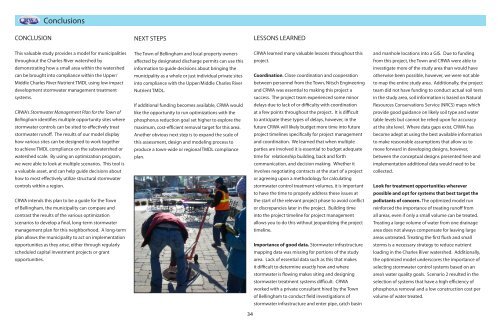Town Center Subbasin Study Report - Bellingham Massachusetts
Town Center Subbasin Study Report - Bellingham Massachusetts
Town Center Subbasin Study Report - Bellingham Massachusetts
- No tags were found...
You also want an ePaper? Increase the reach of your titles
YUMPU automatically turns print PDFs into web optimized ePapers that Google loves.
ConclusionsCONCLUSIONNEXT STEPSLESSONS LEARNEDThis valuable study provides a model for municipalitiesthroughout the Charles River watershed bydemonstrating how a small area within the watershedcan be brought into compliance within the Upper/Middle Charles River Nutrient TMDL using low impactdevelopment stormwater management treatmentsystems.The <strong>Town</strong> of <strong>Bellingham</strong> and local property ownersaffected by designated discharge permits can use thisinformation to guide decisions about bringing themunicipality as a whole or just individual private sitesinto compliance with the Upper/Middle Charles RiverNutrient TMDL.CRWA learned many valuable lessons throughout thisproject.Coordination. Close coordination and cooperationbetween personnel from the <strong>Town</strong>, Nitsch Engineeringand CRWA was essential to making this project asuccess. The project team experienced some minorand manhole locations into a GIS. Due to fundingfrom this project, the <strong>Town</strong> and CRWA were able toinvestigate more of the study area than would haveotherwise been possible, however, we were not ableto map the entire study area. Additionally, the projectteam did not have funding to conduct actual soil testsin the study area, soil information is based on NaturalIf additional funding becomes available, CRWA woulddelays due to lack of or difficulty with coordinationResources Conservations Service (NRCS) maps whichCRWA’s Stormwater Management Plan for the <strong>Town</strong> of<strong>Bellingham</strong> identifies multiple opportunity sites wherestormwater controls can be sited to effectively treatstormwater runoff. The results of our model displayhow various sites can be designed to work togetherto achieve TMDL compliance on the subwatershed orwatershed scale. By using an optimization program,we were able to look at multiple scenarios. This tool islike the opportunity to run optimizations with thephosphorus reduction goal set higher to explore themaximum, cost-efficient removal target for this area.Another obvious next step is to expand the scale ofthis assessment, design and modeling process toproduce a town-wide or regional TMDL complianceplan.at a few points throughout the project. It is difficultto anticipate these types of delays, however, in thefuture CRWA will likely budget more time into futureproject timelines specifically for project managementand coordination. We learned that when multipleparties are involved it is essential to budget adequatetime for relationship building, back and forthcommunication, and decision making. Whether itprovide good guidance on likely soil type and watertable levels but cannot be relied upon for accuracyat the site level. Where data gaps exist, CRWA hasbecome adept at using the best available informationto make reasonable assumptions that allow us tomove forward in developing designs, however,between the conceptual designs presented here andimplementation additional data would need to bea valuable asset, and can help guide decisions aboutinvolves negotiating contracts at the start of a projectcollected.how to most effectively utilize structural stormwateror agreeing upon a methodology for calculatingcontrols within a region.stormwater control treatment volumes, it is importantLook for treatment opportunities whereverto have the time to properly address these issues atpossible and opt for systems that best target theCRWA intends this plan to be a guide for the <strong>Town</strong>the start of the relevant project phase to avoid conflictpollutants of concern. The optimized model runof <strong>Bellingham</strong>, the municipality can compare andor discrepancies later in the project. Building timereinforced the importance of treating runoff fromcontrast the results of the various optimizationinto the project timeline for project managementall areas, even if only a small volume can be treated.scenarios to develop a final, long-term stormwaterallows you to do this without jeopardizing the projectTreating a large volume of water from one drainagemanagement plan for this neighborhood. A long-termtimeline.area does not always compensate for leaving largeplan allows the municipality to act on implementationareas untreated. Treating the first flush and smallopportunities as they arise, either through regularlyImportance of good data. Stormwater infrastructurestorms is a necessary strategy to reduce nutrientscheduled capital investment projects or grantmapping data was missing for portions of the studyloading in the Charles River watershed. Additionally,opportunities.area. Lack of essential data such as this that makesthe optimized model underscores the importance ofit difficult to determine exactly how and whereselecting stormwater control systems based on anstormwater is flowing makes siting and designingarea’s water quality goals. Scenario 2 resulted in thestormwater treatment systems difficult. CRWAselection of systems that have a high efficiency ofworked with a private consultant hired by the <strong>Town</strong>phosphorus removal and a low construction cost perof <strong>Bellingham</strong> to conduct field investigations ofvolume of water treated.stormwater infrastructure and enter pipe, catch basin34






